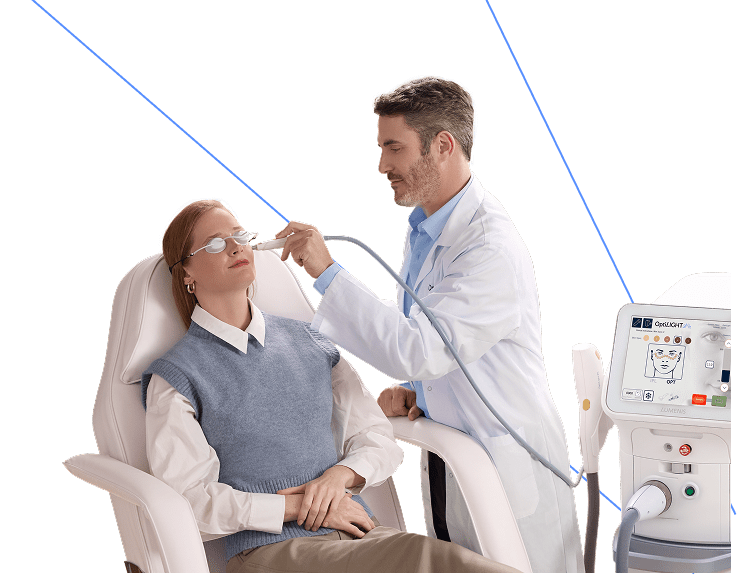
Meet
OptiLIGHT
Lumenis’ first and only FDA approved light therapy for Dry Eye Management
Had enough of dry, itchy eyes? Meet OptiLIGHT, a real solution for dry eye disease arising from MGD (Meibomian Gland Dysfunction), the foremost cause behind this condition. Utilizing patented OPT™ technology, OptiLIGHT is a light-based treatment thoughtfully designed to reach even the most delicate treatment areas, ensuring an experience that is safe, precise and gentle. 4
-
Innovative light therapy for brighter results
-
Targets multiple key contributors of dry eyes for lasting results
-
Finally reduces your dependency on eye drops
-
Developed with safety in mind, for your peace of mind
Ready to give your dry eyes the real solution they deserve?
 Locating your nearest doctor
Locating your nearest doctor


Find A Doctor
Suffering from dry, red, itchy eyes?
Join the
“Not Gonna
Live With It”
Generation
Americans are estimated to suffer from dry eye disease, only half are diagnosed ¹
of patients are frustrated by their dry eye condition ²
of patients wish there was something more effective to treat their dry eye ³
Do You Have Dry Eyes?
Find A DoctorFAQs
OptiLIGHT is a light-based treatment that uses precise, intense broad spectrum light to address signs of dry eye disease due to meibomian gland dysfunction (MGD). MGD is the most common cause of dry eye disease, accounting for about 86% of cases. The treatment addresses inflammation, which is one of the key underlying factors in MGD. OptiLIGHT was specifically developed to reach the delicate contours of the treated area safely, effectively, and gently using the OPT™ technology. It is intended for use in patients who are at least 22 years old, together with other available treatments, such as Meibomian gland expression, artificial tear lubricants, and warm compresses
Lumenis’ patented technology OPT™ (Optimal Pulse Technology) transforms the use of light and allows targeted, uniform, precise, and controlled treatment. Specifically designed for the delicate area below the eye, OPT™ safely and effectively breaks the vicious cycle of inflammation associated with dry eye.
OptiLIGHT is a multi-factorial treatment for a multi-factorial disease. It addresses the disease by reducing major sources of inflammation leading to dry eye disease such as abnormal blood vessels, Demodex mites, and pro-inflammatory agents. OptiLIGHT restores the function of meibomian glands and delays evaporation of the tear film.
Treatment protocol typically consists of 4 sessions, at 2 to 4 weeks apart:
- During treatment, your practitioner will cover your eyes with shields and apply a thin layer of coupling gel on the treatment area.
- During treatment, light is applied on the skin below the eyes, most patients report minimal discomfort.
- OptiLIGHT is followed by meibomian gland expression.
- Each session takes only 10-15 minutes. There is no downtime, you can resume your daily activities immediately.
Patients typically report improvement after 2 to 3 treatments. For optimal results, 4 sessions are advised. To ensure long-term results, a maintenance session is recommended every 6-12 months.
You may experience some redness immediately following treatment. This will usually disappear within a few hours. You can return to your daily activities and apply makeup straight away in most cases. You will be advised to stay out of direct sunlight for a few days and to apply sunscreen.
Potential risks and side effects of using OptiLIGHT on your skin may include pain/ discomfort, damage to natural skin texture, change of pigmentation, scaring, excessive edema, fragile skin, bruising, burns, pruritus and xerosis. You should consult with your physician about these risks and whether treatment with OptiLIGHT is suitable for you.
Treatment with OptiLIGHT is contraindicated for patients with the following conditions in the treatment area: Ocular surgery or eyelid surgery or Neuro-paralysis within 6 months prior to the first treatment; Uncontrolled eye disorders affecting the ocular surface; Pre-cancerous lesions, skin cancer or pigmented lesions in the planned treatment area; Uncontrolled infections or uncontrolled immunosuppressive diseases; Recent Ocular infections; Prior history of cold sores or rashes in the perioral area, including: Herpes simplex 1 u0026amp; 2, Systemic Lupus erythematosus and porphyria; Use of photosensitive medication and/or herbs that may cause sensitivity within 3 months prior to the first IPL session; Recent radiation therapy to the head or neck or planned radiation therapy; Recent treatment with a chemotherapeutic agent or planned chemotherapy; History of migraines, seizures or epilepsy.







